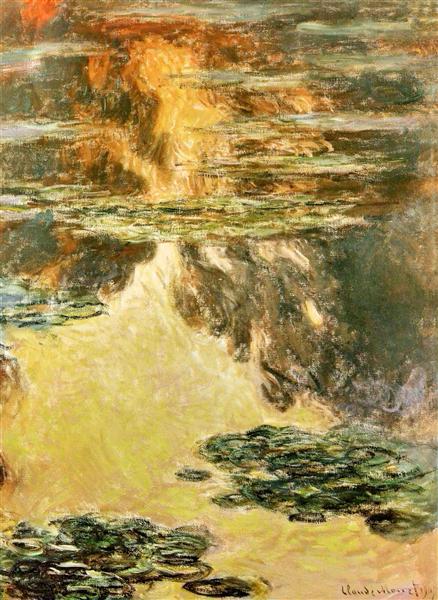Beskrivning
Claude Monet's 1907 painting "Water Lilies" stands as an iconic work that encapsulates the essence of the Impressionist movement and its creator's philosophy. In this piece, Monet focuses on water and its reflective surface, offering an almost abstract representation of the natural world. With no human characters in sight, the work delves into a dialogue between nature and the observer's perception, inviting introspective contemplation.
Compositionally, Monet opts for an approach that prioritizes the deployment of color and texture. The work is dominated by a wide range of greens, blues, and lilacs, suggesting the rich vegetation and serenity of the pond. The brushstrokes are loose and fluid, a hallmark of his style, seeming to capture the transience of light on the surface of the water. As the hues intertwine, a sense of movement is created, as if the viewer can feel the gentle breeze caressing the surface of the pond, momentarily disturbing the stillness of the water lilies.
The superposition of shapes and colours makes the pond appear to be a world in itself, where the boundaries between sky and water are blurred, thus blurring the barriers of objective reality. This effect of visual ambiguity is characteristic of Monet, who was interested in how light altered the perception of the landscape, leading him to experiment with capturing fleeting moments of nature. In this work, the viewer finds himself immersed in an environment where the illusion of depth plays a crucial role, providing an almost immersive experience.
Compared to other works in the Water Lilies series, this painting stands out for its almost dreamlike tone, inviting meditation on nature and its contemplation. Monet devoted much of his life to painting his garden at Giverny, and this series is considered the pinnacle of his career. The symbolism of water lilies in art also deserves mention: they represent purity and depth of soul, an echo of Monet's interest in the spirituality implicit in nature.
The use of color is particularly notable in “Water Lilies.” The chosen palette reflects a harmony that goes beyond imitation of the natural world, suggesting instead a sense of peace and connection with the surroundings. Each brushstroke seems to be a celebration of color and light, an essential characteristic of Impressionism that Monet helped define. The way the darker and lighter tones are juxtaposed seems to evoke a dialogue between shadow and light, which in turn enhances the almost musical quality of the composition.
Many critics have analyzed the influence of this style of painting on contemporary art. The way Monet broke with the traditional representation of landscape paved the way for future generations of artists who would seek to capture the essence of the visual experience rather than mere representation. When looking at "Water Lilies," the viewer not only appreciates the beauty of the water and flora, but is also immersed in a process of recognizing one's own perception and experience.
In conclusion, Monet's work is not just a simple landscape; it is an invitation to immerse oneself in a world where time and space are reconfigured through light and color. "Water Lilies" from 1907 is, in this sense, a testament to Monet's mastery and his lasting impact on art, marking a milestone in the evolution of Impressionism and the focus on the subjectivity of visual experience. Through this work, Monet offers not just an image, but a sensory experience that resonates throughout time.
KUADROS ©, a famous painting on your wall.
Hand-made oil painting reproductions, with the quality of professional artists and the distinctive seal of KUADROS ©.
Painting reproduction service with satisfaction guarantee. If you are not completely satisfied with the replica of your painting, we will refund 100% of your money.

